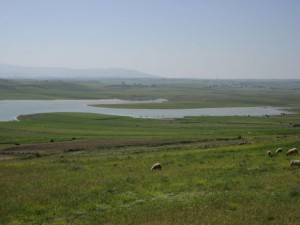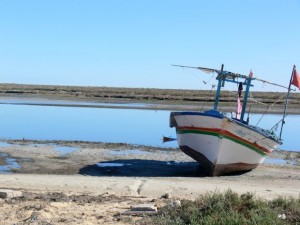 Following on from Tunisia’s designation of 15 new Wetlands of International Importance for World Wetlands Day earlier this year, the paperwork has been completed for a further two significant sites. As summarized by Ms. Ako Charlotte Eyong, Ramsar’s Assistant Advisor for Africa, Barrage Mlaabi (98 hectares, 36°49’44″N 010°59’07″E) is a freshwater storage area on the Cap Bon peninsula constructed mainly for ground water recharge, serving today for irrigation of summer plants. It supports several populations of waterbirds migrating between African wintering grounds and Eurasian breeding grounds as well as North African endemic species including IUCN red-listed White-headed Duck (Oxyura leucocephala, up to 32 individuals) and Marbled Teal (Marmaronetta angustirostris). The main habitats are shallow lake waters that host aquatic plant species, principally dense populations of Ruppia cirrhosa and Zannichellia palustris. The main land use is agriculture (mainly cereal farming upstream, animal rearing on mountainsides, vegetable, fruits and tobacco cultivation downstream).
Following on from Tunisia’s designation of 15 new Wetlands of International Importance for World Wetlands Day earlier this year, the paperwork has been completed for a further two significant sites. As summarized by Ms. Ako Charlotte Eyong, Ramsar’s Assistant Advisor for Africa, Barrage Mlaabi (98 hectares, 36°49’44″N 010°59’07″E) is a freshwater storage area on the Cap Bon peninsula constructed mainly for ground water recharge, serving today for irrigation of summer plants. It supports several populations of waterbirds migrating between African wintering grounds and Eurasian breeding grounds as well as North African endemic species including IUCN red-listed White-headed Duck (Oxyura leucocephala, up to 32 individuals) and Marbled Teal (Marmaronetta angustirostris). The main habitats are shallow lake waters that host aquatic plant species, principally dense populations of Ruppia cirrhosa and Zannichellia palustris. The main land use is agriculture (mainly cereal farming upstream, animal rearing on mountainsides, vegetable, fruits and tobacco cultivation downstream).
 The second new site, with the daunting title of Complexe des zones humides des Chott el Guetayate et Sebkhet Dhreia et Oueds Akarit, Rekhama et Meleh (4,845 hectares, 34°06’59″N 010°01’47″E), lies farther down the coast, comprising intertidal marshes situated in an estuarine coastal environment including beaches and bluffs, crossed by several valleys extending to the Gulf of Gabes. The site supports several waterbird species including the Eurasian Curlew (Numenius arquata), Northern Shoveler (Anas clypeata) and Dunlin (Calidris alpina). Several fish species have been identified here, including migrating species such as the IUCN red-listed catadromous European Eel (Anguilla anguilla), estuarine fish species such as the South European toothcarp (Aphanius fasciatus), and marine bivalves. The diversity of habitats encourages the presence of a rich plant diversity including halophytes, perennials and annuals as well as dense tamarisk forests. Its main hydrological values include groundwater recharge, water retention and flood regulation. Main land uses include agriculture and fishing, and it is an important archaeological and cultural site with great historical value.
The second new site, with the daunting title of Complexe des zones humides des Chott el Guetayate et Sebkhet Dhreia et Oueds Akarit, Rekhama et Meleh (4,845 hectares, 34°06’59″N 010°01’47″E), lies farther down the coast, comprising intertidal marshes situated in an estuarine coastal environment including beaches and bluffs, crossed by several valleys extending to the Gulf of Gabes. The site supports several waterbird species including the Eurasian Curlew (Numenius arquata), Northern Shoveler (Anas clypeata) and Dunlin (Calidris alpina). Several fish species have been identified here, including migrating species such as the IUCN red-listed catadromous European Eel (Anguilla anguilla), estuarine fish species such as the South European toothcarp (Aphanius fasciatus), and marine bivalves. The diversity of habitats encourages the presence of a rich plant diversity including halophytes, perennials and annuals as well as dense tamarisk forests. Its main hydrological values include groundwater recharge, water retention and flood regulation. Main land uses include agriculture and fishing, and it is an important archaeological and cultural site with great historical value.
The full Ramsar Information Sheets and maps for these sites, which were prepared with assistance from WWF Tunisia, will be soon available on Wetlands International’s Ramsar Sites Information Service, and Oued Akarit can be found on the Critical Site Network Tool developed by Wetlands International, BirdLife International, and UNEP-WCMC as part of the Wings Over Wetlands (WOW) project.
Source: Ramsar Convention
Share